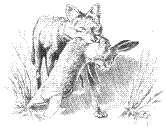Center, Internet, Wildlife Damage Management

Coyotes in the Southwest: A Compendium of Our Knowledge (Symposium Proceedings, 1995)
Date of this Version
January 1995
Document Type
Proceeding
Citation
Published in Coyotes in the Southwest: A Compendium of Our Knowledge, Symposium Proceedings, December 13–14, 1995, San Angelo, Texas
Edited by Dale Rollins, Calvin Richardson, Terry Blankenship, Kem Canon, and Scott Henke
Abstract
Coyotes (Canis latrans) occur sympatrically with several predators throughout their range. Habitat and food resources are similar, although the coyote typically utilizes a wider range of food items. Larger predators generally select larger prey, allowing predators of different sizes to coexist. Coyotes exhibit aggressive actions towards smaller predators, but in most cases they avoid contact with other predator species. Studies indicate that coyotes can exclude 01- displace foxes (Vulpes vulpes, Urocyon spp.), and an inverse relationship exists between abundance of coyotes and foxes. There is evidence suggesting that extensive reduction of coyote populations allows other predator populations to increase.


Comments
Published 1996, Austin, Texas. Used by permission